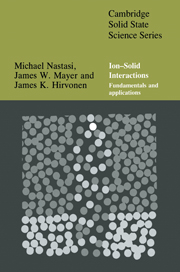Book contents
- Frontmatter
- Contents
- List of symbols
- Preface
- Chapter 1 General features and fundamental concepts
- Chapter 2 Interatomic potentials
- Chapter 3 Dynamics of binary elastic collisions
- Chapter 4 Cross-section
- Chapter 5 Ion stopping
- Chapter 6 Ion range and range distribution
- Chapter 7 Radiation damage and spikes
- Chapter 8 Ion–solid simulations and diffusion
- Chapter 9 Sputtering
- Chapter 10 Order–disorder and ion implantation metallurgy
- Chapter 11 Ion beam mixing
- Chapter 12 Phase transformations
- Chapter 13 Ion beam assisted deposition
- Chapter 14 Applications of ion beam processing techniques
- Chapter 15 Ion beam system features
- Appendix A Crystallography
- Appendix B Table of the elements
- Appendix C Density of states
- Appendix D Derivation of the Thomas–Fermi differential equation
- Appendix E Center-of-mass and laboratory scattering angles
- Appendix F Miedema's semi-empirical model for the enthalpy of formation in the liquid and solid states
- Appendix G Implantation metallurgy – study of equilibrium alloys
- Appendix H Physical constants, conversions and useful combinations
- Index
Chapter 4 - Cross-section
Published online by Cambridge University Press: 27 January 2010
- Frontmatter
- Contents
- List of symbols
- Preface
- Chapter 1 General features and fundamental concepts
- Chapter 2 Interatomic potentials
- Chapter 3 Dynamics of binary elastic collisions
- Chapter 4 Cross-section
- Chapter 5 Ion stopping
- Chapter 6 Ion range and range distribution
- Chapter 7 Radiation damage and spikes
- Chapter 8 Ion–solid simulations and diffusion
- Chapter 9 Sputtering
- Chapter 10 Order–disorder and ion implantation metallurgy
- Chapter 11 Ion beam mixing
- Chapter 12 Phase transformations
- Chapter 13 Ion beam assisted deposition
- Chapter 14 Applications of ion beam processing techniques
- Chapter 15 Ion beam system features
- Appendix A Crystallography
- Appendix B Table of the elements
- Appendix C Density of states
- Appendix D Derivation of the Thomas–Fermi differential equation
- Appendix E Center-of-mass and laboratory scattering angles
- Appendix F Miedema's semi-empirical model for the enthalpy of formation in the liquid and solid states
- Appendix G Implantation metallurgy – study of equilibrium alloys
- Appendix H Physical constants, conversions and useful combinations
- Index
Summary
Introduction
In Chapters 2 and 3 we developed concepts essential to our understanding of ion–solid interactions. In Chapter 3 we derived equations describing the kinematics of binary elastic collisions. These equations enable us to calculate the amount of energy transferred to a target atom in a collision when the scattering angle of the projectile or the target atom is known. Conversely, we could calculate the scattering angles if the amount of energy loss in the collision were known. At the end of Chapter 3 we developed an expression for the center-of-mass scattering angle, θc, which is a function of the ion energy, the impact parameter b, and the interatomic potential energy V(r). The details of the interatomic potential energy were discussed in Chapter 2.
In Chapter 4 we will examine the probability of ion–solid scattering events. During ion irradiation and ion implantation experiments, many ions or energetic particles interact with many target nuclei. Due to the large number of interactions, the questions of how much energy will be transferred in a collision or what the scattering angle will be must be answered using statistics and probability. The differential cross-section is the fundamental parameter that we will develop. It gives a measure of either the probability of transferring energy T in the range between T and T + dT to a target atom or of the probability of scattering a projectile into some angle between θc and θc + dθc.
- Type
- Chapter
- Information
- Ion-Solid InteractionsFundamentals and Applications, pp. 62 - 87Publisher: Cambridge University PressPrint publication year: 1996



